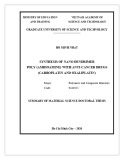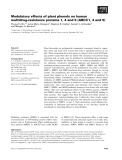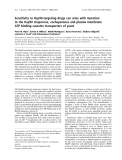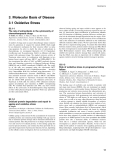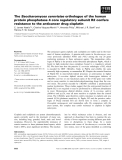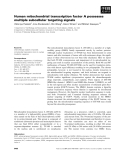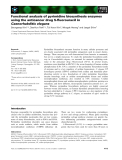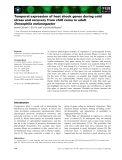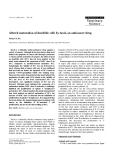
Anti-cancer drugs
-
Objective: Study on synthesis of nano dendrimer PAMAM with anticancer drugs carboplatin (CAR) and oxaliplatin (OXA) to reduce the toxicity of the drug to normal cells and improve the effectiveness on cancer cell destruction by increasing solubility, increasing drug storage capacity, targeting drugs passively.
 27p
27p  extraenglish
extraenglish
 24-05-2021
24-05-2021
 24
24
 4
4
 Download
Download
-
Plant flavonoids are polyphenolic compounds, commonly found in vegeta-bles, fruits and many food sources that form a significant portion of our diet. These compounds have been shown to interact with several ATP-bind-ing cassette transporters that are linked with anticancer and antiviral drug resistance and, as such, may be beneficial in modulating drug resistance. This study investigates the interactions of six common polyphenols; querce-tin, silymarin, resveratrol, naringenin, daidzein and hesperetin with the multidrug-resistance-associated proteins, MRP1, MRP4 and MRP5. ...
 16p
16p  fptmusic
fptmusic
 12-04-2013
12-04-2013
 41
41
 2
2
 Download
Download
-
The Hsp90 molecular chaperone catalyses the final activa-tion step of many of themost important regulatory proteins of eukaryotic cells. The antibiotics geldanamycin and rad-icicol act as highly selective inhibitors of in vivo Hsp90 function through their ability to bindwithin the ADP/ATP binding pocket of the chaperone. Drugs based on these compounds are now being developed as anticancer agents, their administration having the potential to inactivate sim-ultaneously several of the targets critical for counteracting multistep carcinogenesis. ...
 7p
7p  fptmusic
fptmusic
 12-04-2013
12-04-2013
 48
48
 3
3
 Download
Download
-
The spontaneous acquisition of resistance to a variety of unrelated cytotoxic compounds has important implications in medical treatment of infectious diseases and anticancer therapy. In the yeast Saccharomyces cerevisiaethis pheno-menon is caused by overexpression of membrane efflux pumps and is called pleiotropic drug resistance. We have found that allelic forms of the genes for the transcription activators Pdr1p and Pdr3p, designated PDR1-12and PDR3-33,respectively, mediate resistance to diazaborine....
 8p
8p  dell39
dell39
 03-04-2013
03-04-2013
 39
39
 3
3
 Download
Download
-
A number of drugs used in cancer chemotherapy induce oxidative stress by generation of oxygen free radicals (ROS) which might be an alternative mechanism for their cytotoxic effect via indu-cing apoptosis. In order to clarify the roles of antioxidants in chemotherapy, we investigated Quercetin (3,3’,4’,5,7-pentahyd-roxyflavone) and N-acetylcysteine (NAC) in different cell types treated with anticancer drugs. We studied cytotoxic activity of Topotecan alone and/or in combination with Quercetin in two human breast cancer cell lines, MCF-7 and MDA-MB-231. ...
 7p
7p  inspiron33
inspiron33
 26-03-2013
26-03-2013
 57
57
 4
4
 Download
Download
-
The anticancer agents cisplatin and oxaliplatin are widely used in the treat-ment of human neoplasias. A genome-wide screen inSaccharomyces cere-visiae previously identified PPH3and PSY2among the top 20 genes conferring resistance to these anticancer agents. The mammalian ortho-logue of Pph3p is the protein serine⁄threonine phosphatase Ppp4c, which is found in high molecular mass complexes bound to a regulatory subunit R2.
 13p
13p  inspiron33
inspiron33
 25-03-2013
25-03-2013
 39
39
 4
4
 Download
Download
-
The mitochondrial transcription factor A (TFAM) is a member of a high-mobility group (HMG) family represented mostly by nuclear proteins. Although nuclear localization of TFAM has been demonstrated in some tumors and after treatment of tumor cells with anticancer drugs, the signifi-cance of these observations has not been fully elucidated.
 12p
12p  media19
media19
 05-03-2013
05-03-2013
 38
38
 2
2
 Download
Download
-
Pyrimidine biosynthesis enzymes function in many cellular processes and are closely associated with pyrimidine antagonists used in cancer chemo-therapy. These enzymes are well characterized from bacteria to mammals, but not in a simple metazoan. To study the pyrimidine biosynthesis path-way inCaenorhabditis elegans, we screened for mutants exhibiting resis-tance to the anticancer drug 5-fluorouracil (5-FU).
 12p
12p  vinaphone15
vinaphone15
 25-02-2013
25-02-2013
 53
53
 3
3
 Download
Download
-
Taxanes and other microtubule-stabilizing agents comprise an important class of anticancer drugs. It is well known that taxanes act by binding to b-tubulin on the lumenal side of microtubules. However, experimental evi-dence obtained in recent years led to the hypothesis of an external site on the microtubule wall to which taxanes and other microtubule-stabilizing agents could bind before being internalized to their lumenal site.
 12p
12p  viettel02
viettel02
 22-02-2013
22-02-2013
 28
28
 4
4
 Download
Download
-
Bacterial RNases are promising tools for the development of anticancer drugs. Neoplastic transformation leads to enhanced accumulation of rRNA and tRNA, and altered expression of regulatory noncoding RNAs. Cleav-age of RNA in cancer cells is the main reason for the cytotoxic effects of exogenic RNases.
 12p
12p  mobifone23
mobifone23
 18-01-2013
18-01-2013
 59
59
 6
6
 Download
Download
-
Tuyển tập các báo cáo nghiên cứu khoa học quốc tế về bệnh thú y đề tài: Altered maturation of dendritic cells by taxol, an anticancer drug
 6p
6p  hoami_266
hoami_266
 16-09-2011
16-09-2011
 51
51
 2
2
 Download
Download
CHỦ ĐỀ BẠN MUỐN TÌM








